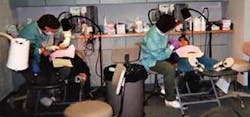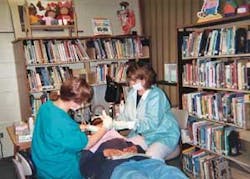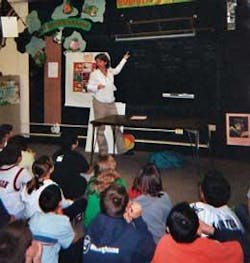A week flies by in public health
by Lisa Sherman, RDH
Several years have passed since college graduation, but at night, my dreams serve as constant reminders of school. In these dreams, I'm terribly stressed because it's almost the end of a semester and deadlines are quickly approaching. Then, fear grips me as I realize that I missed a class. In similar dreams, I find myself in the present, but returning to school because I never finished. It's hard to believe that these dreams have persisted since 1990, when I earned my associate's degree in dental hygiene.
Prior to graduation, I began looking into baccalaureate programs. Southern Illinois University offered a selection of bachelor's degrees that would enhance my AAS degree. I chose the most general degree that Carbondale offered, which was Advanced Technical Studies. My future was uncertain, and, since I simply wanted the ability to "open doors" of opportunity, this seemed to offer the most versatility. The degree program consisted of general education, electives, and a core curriculum that included statistics, management, technical writing, and public health. Public Health ... the concept was intriguing.
For nine years following graduation, I practiced full-time clinical dental hygiene. I worked in three different offices, travelling between two states. I really enjoyed my profession and was passionate about making a difference in the quality of my patient's lives through their dental health.
I was quite content with clinical private practice, when I learned that a hygiene position was available at the local health department. It seemed worth investigating, and I just happened to have the requisite bachelor's degree. The interviews went well and the variety and flexibility of the job was attractive. Great benefits made up for the lower pay and it was only a 30-hour, 4-day per week position. I proudly accepted the offer, and was excited about the challenges ahead.
Our dental services program is part of a large, suburban county health department. Our staff is comprised of six hygienists, which are mostly part-time, and one full-time hygienist who serves as our program coordinator. We offer a variety of dental services to our community, such as:
• A variety of dental health education programs
• Health fair participation
• A school-based fluoride rinse program
• A yearly continuing education seminar, and several other large events intended for dental wellness screening or treatment.
Additionally, during the school year, we focus largely on the school-based, grant-funded sealant program. During an average year, we will visit approximately 35 schools and screen nearly 5,000 children. Another large component of our dental services program is the Urgent Care Clinic, which has the primary function of eliminating pain and infection for income-eligible county residents who are without dental insurance or Medicaid.
There is never a dull moment in public health, and there is always a chance to experience something new. When I continued my education to "open doors" for opportunity, I never imagined personal rewards that would come from caring for so many individuals with such challenging lives.
To provide you with a better understanding of dental hygiene in the public health setting, I'd like to share some of my most recent experiences:
Monday: For the first time in our 12-year sealant program history, we were scheduled at a high school. We had visited the "feeder-" middle school a few days before. As I was entering the school, I was privately fantasizing that I might hear, "Young lady, do you have a hall pass?" Instead, I was greeted respectfully and escorted to the treatment area. My fantasy fizzled as I realized that it must have been the scrubs that gave me away.It took us about an hour to organize and set up the portable equipment. We have learned how to be very creative in some extremely small spaces. Sometimes we are fortunate enough to have the use of an entire classroom or a large part of the library. At other times, we are crammed into a tiny conference room, hallway, or even onto a stage. This time, we were setting up in a spacious lounge. Our presence in a school is always noticeable by the lingering odor of our disinfectants.
There was a very diverse ethnic mix in this particular school district, largely due to a local organization that helps various immigrants settle in the United States. We treated immigrant children from Russia, North Osetia-Alania, Yugoslavia, Serbia, and Bosnia, as well as Kurdish and African Bantu children.
Any child possessing a signed consent form, a requirement for eligibility, may participate in the sealant program. During this visit, the staff dentist screened 53 students, and 21 had sealants placed by the hygienists. It was actually a very slow day, and we enjoyed the ease of working with teenagers.
We have a really efficient system, which allows us to place many sealants on the children, while minimizing their time away from class. Whenever possible, we team up so that we can assist one another. One hygienist is positioned on each side of the patient and is responsible for placing sealants on that side of the patient's mouth. Most of us are right-handed, so we have really learned how to be ambidextrous. The teams also share the tasks of breaking down, disinfecting, and setting up the sealant stations.
We routinely compile reports on decay rates, or the percentage of participating students that had at least one area of apparent decay. At the high school, the decay rate was 51%. Several participants were already missing permanent molars. The decay rate of the participants at the middle school was an astounding 63 percent. Each student participant is sent home with a letter that indicates our findings, whether or not teeth were sealed, and a listing of referral resources.
Wednesday: I was assigned to present a dental health education program for a middle school's special education class. There were about 15 children, mostly with behavioral issues or ADHD. For this age group, I like to engage their attention right away by discussing how dental health can affect appearance. Adolescent children can be motivated by anything gross or disgusting, so bad breath was the perfect topic. I discussed the negative effects of poor oral hygiene, reviewed self-care, and briefly touched on the oral ramifications of smoking and substance abuse.Then, we played an educational guessing game about sugar and nutrition. Using an eraser board, I provided two slightly different foods or drinks, such as orange juice and Gatorade, and they had to guess which one had less sugar. Throughout the program, the kids were very polite and interactive. Afterwards, the teacher said she was very pleased with the program and commended me for keeping the attention of an autistic boy.
I left the school feeling great, knowing that everyone in the class had learned something valuable. Working with adolescents is enjoyable for me. Their programs require a lot of creativity, because holding their interest can be quite challenging.
Thursday: I reported to a local nursing home to provide two identical staff education sessions. Fifteen Certified Nursing Assistants participated in each program. As the CNAs were filing into the room, I engaged them in conversation. Without being too direct, I asked one CNA what type of oral hygiene care she provided for her residents. She was very vague and mentioned something about cleaning their fingernails. Needless to say, this concerned me. The purpose of the program was to educate them on the recognition and reporting of potential oral abnormalities, along with instruction on resident oral hygiene care. Posters were used to show oral cancer and the stages of periodontal disease. A 30-minute videotape on resident oral hygiene care followed. These "professionals" had less of an attention span than the special-ed adolescents. At one point during the videotape, several were laughing about a young man who had fallen asleep. I diffused the situation by making light of it and everyone laughed even more. After each program, few participants cared enough to ask questions. Attempting to educate CNAs can be really frustrating. While many of them can be compassionate and hard working, the occupation has low pay and high turnover. I left those programs feeling somewhat aggravated and disappointed and was haunted by the fingernail story. It made me think about state law reforms that should permit nursing homes to employ dental hygienists to provide ongoing preventive care and make referrals for dental examinations and restorative work.Friday: I worked between our office and the Urgent Care Clinic, mostly providing screenings for our Low Cost Dental Referral Program. In order for clients to be enrolled, they must show proof of eligibility and have an apparent dental need. Then, participating dentists throughout the county will provide services at a reduced fee in their private offices. Today, I screened the following clients:• Two elderly ladies from an assisted-living facility arrived together. One presented with a full set of ill-fitting dentures that she had worn for the last 45 years. I enrolled her into the Low Cost Dental Referral Program. Her friend had no personal concerns and since her screening was inconsequential, I referred her to our local dental hygiene school for preventive care.
• A 36 year-old, Spanish-speaking male, who had previously visited our Urgent Care Clinic, came in next. There was a healing extraction site in the vicinity of tooth #30, and tooth #19 was fractured but asymptomatic. A bilingual staff member translated and we enrolled him in the referral program.
• A 29 year-old, male chiropractic student came in complaining that tooth #2 had lost a large amalgam, which he produced from his pocket. At least four other teeth or fillings were also fractured, and symptom-free. He was enrolled in the referral program, as well.
• A 44 year-old female resident of a substance and alcohol abuse recovery facility presented with a partial dentition and many teeth with considerable mobility. I enrolled her in the referral program for further evaluation and consultation.
• A 9 year-old boy presented with decay on two primary molars. His four permanent first molars appeared healthy. Since he was a student at a scheduled school, I gave his mother a consent form to complete for the sealant program. He was also enrolled in the referral program for the restorative work.
We are so grateful that there are dentists willing to help these adults and children. On the average, we refer 50 clients per month to the participating dentists.
The following week: We arrived for our annual visit to an elementary school in a different school district. As usual, we had to squeeze four portable chairs and units into a very small nurse's office. At times, the room would get terribly hot and the one tiny, unreachable window offered no relief. In the past, our compressors had even caused blown electrical fuses at this school.
Hispanic children made up most of the student population, and many had never seen a dentist. Some of them were fearful and would ask, "Is this going to hurt?" We provided a lot of reassurance and transformed many of the kids into believers. Sometimes a child will ask if the etchant or sealant syringes are "shots." We call the etchant the "blue pencil" and sealants can be referred to as "white snowflakes or flowers," depending upon the season.
We spent two days at that school and the dentist screened 239 children; 82 children received 246 sealants. Of the 239 children, 99 of them already had sealants, mostly from our previous visits. The decay rate was 49 percent with an average of 3.5 decayed teeth per child. Nine of the children had apparent abscesses.
Most of the letters we sent home with the children were in Spanish. With concern about the high incidence of infection in this particular school district, we made arrangements for a local pedodontist to volunteer a morning in our clinic, to care for the kids with abscesses.
Nearly half of the screened, income-eligible children are recipients of Medicaid. Their decay rates are slightly higher than those without coverage. A listing of local Medicaid providers is always included in the letters the children take home to their parents.
I thoroughly enjoy working in public health. Despite the wealth in this county, there is an entire population that is unable to obtain treatment in private practices. It is so satisfying and rewarding to have the opportunity to educate and help those in need. Of course, there are times when it can be aggravating to see a child with severe decay, wearing tons of gold jewelry or expensive gym shoes, but there are not very many.
True satisfaction will come from making a referral to the dental school for a full-mouth reconstruction or a difficult denture case. Perhaps, it will come from educating a young, naive expectant mother about preventing a pre-term, low birth weight baby or early childhood caries.
Whether it's discussing the causes of dry mouth or just seeing a child experience his first positive dental experience, public health is very exciting. I am so glad that my expanded education allowed me to pursue this unexpected opportunity. I urge others to do the same. Public health is now in my blood and has truly become my career passion. If life's events ever lead to another job change, I plan to continue down a similar path, within the scope of dental hygiene.
As for the dreams, perhaps they're just the product of a sound night's sleep after a long day at a job that is truly fulfilling.
Lisa Sherman, RDH, has been a public health dental hygienist at the DuPage County Health Department in Wheaton, Ill., for the past four years. Lisa is serving her second term as component trustee for the West Suburban Dental Hygienist's Association. She and her husband, Mike, an executive at KaVo America Corporation, are expecting their first children, twins, in January, 2005. Lisa can be contacted at [email protected].



